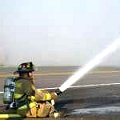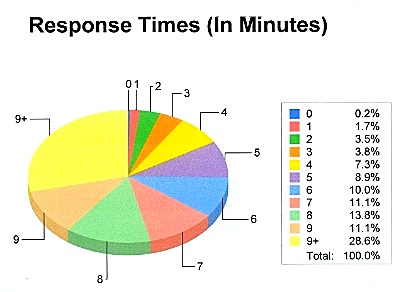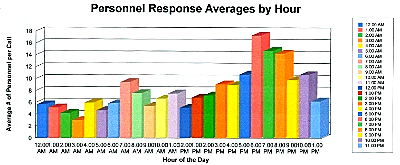- By Dan Veaner
- News
 Print
Print  If you could choose when your Lansing house catches fire -- and we're not implying that you should -- your best bet would be around 7pm. That's when the largest number of volunteer responders are likely to be available. This year's statistics to date even surprised Fire Chief Scott Purcell when they showed that despite some emergency calls that took over 12 minutes, the average response time for all fire and EMS calls was an impressive 7.86 minutes, with plenty of available volunteer responders. In fact, response times for just under half of the 640 calls from January 1 through August 31 were seven minutes or less.
If you could choose when your Lansing house catches fire -- and we're not implying that you should -- your best bet would be around 7pm. That's when the largest number of volunteer responders are likely to be available. This year's statistics to date even surprised Fire Chief Scott Purcell when they showed that despite some emergency calls that took over 12 minutes, the average response time for all fire and EMS calls was an impressive 7.86 minutes, with plenty of available volunteer responders. In fact, response times for just under half of the 640 calls from January 1 through August 31 were seven minutes or less."When I ran the numbers I thought that number was going to be higher," he says. "That was kind of a shock."
The good kind of shock. The National Fire Protection Association (NFPA) sets objectives for volunteer fire responses in rural areas of less than 500 people/mile that specify a minimum of 6 responders and a 14 minute response time. Suburban areas are defined as having 500–1000 people/mile, and specifies a minimum of 10 responders and a 10 minute respose time. 80% of calls are expected to meet those numbers. The NFPA uses a response time metric that begins upon completion of the dispatch notification, not at the time when a 911 call is initiated. In 2012 the national average for EMS calls was slightly over 10 minutes, which puts Lansing in line or better than average.
When volunteer fire departments get a call from a 911 dispatcher, volunteers who are available may respond if they are able. They have to get to a fire station to pick up fire trucks and equipment, though some responders might go directly to the scene to support responders who arrive with the equipment. Rural emergency responses typically take longer than those in urban areas.
The Lansing Volunteer Fire Department has stepped up their 'bunker' program in the past couple of years, building bunking facilities in an addition at Central Station (across Ridge Road from Cargill) and in the new Village of Lansing fire station on Oakcrest Road. Purcell credits the Board of Commissioners for having the forsight to buil the new facilities. Bunkers live in a fire station, which can increase response time because they can immediately respond to emergencies with equipment. But that is only possible sometimes, as they might be at work or somewhere else when an alarm comes in. Even so, Purcell says he has noticed an improvement in response times since bunkers moved in.
"The fact that we have bunkers is the reason for the lowered response time," he says. "I can not guarantee a 8 minute response 24/7 but on average that it what it has been this year. I think that is good for a volunteer department considering that a minimum paid crew 24/7 would be at least 2 million dollars and that is just a minimum. If we went all paid we would be looking at 7-10 million extra a year."
 Note: charts show statistics are for all Lansing Volunteer Fire Department responses, including both fire and EMS. Chart courtesy of Scott Purcell
Note: charts show statistics are for all Lansing Volunteer Fire Department responses, including both fire and EMS. Chart courtesy of Scott PurcellLansing responses average 8 volunteers per call with an average high of 17 at 7pm. But those numbers don't tell the whole story. With 349 fire calls and 291 EMS calls through August, the lower number of EMS responders, typically one, two, or three at the most, brings down the average on the fire side.
"Take half our calls are EMS where one, two, or three people at the most are responding from here," Purcell says. "I think an average of 8 people for all our calls is pretty good. We had six structure fires -- that might be a structure fire or a chimney fire. We've had 349 fire calls through the end of August. Of those fire alarms 123 were false alarms -- that's 35%."
Normally there EMS/fire calls are 55%/45% or 60%/40%, but this year there have been more fire calls (54.5) than EMS (45.5%) calls because of the storm calls that fall in the fire response category. Multi-storm calls are typically for downed wires or trees, or flooding. In the busy times Purcell or Deputy Chief Brad George performs triage on the calls, giving priority to downed electrical wires.
It's usually flip-flopped, but we had all those storm calls," Purcell says. "When you get 15 to 19 calls one night and the next week you have the same thing, it means more fire calls. But it's usually the opposite."
 Chart courtesy of Scott Purcell
Chart courtesy of Scott PurcellFalse alarms tend to come from dirty sensor heads on ceiling fire detectors or residential calls from an alarm company even if it is only from too much cooking smoke that is not causing a real emergency.
"If there is a little bit of smoke that sets it off, once the alarm company gets it they send it to us. If you have an alarm at your house and you say 'My wife just burned something. We're fine.' Dispatch will still send us."
Purcell notes that Bangs Ambulance also responds to EMS calls. He says Bangs is likely to appear at the most remote Lansing calls in the north of the town within 12 to 14 minutes. In many cases Lansing EMS volunteers arrive first, but in cases where they do not, Bangs is there to serve those calls. Purcell says that the lower number of volunteers inb the early mornings don't mean that nobody will respond.
"Most of the calls at 2 -5 am are EMS only calls," he explains. "They only require 1 or 2 people to respond. I just want to make sure people know that so they won’t worry if they have a fire that only three people would show up."
He says that of the 68 calls for which responses were 12 minutes or more, 32 were EMS calls, and 14 were mutual aid calls in different communities that take longer to get to because they are farther away. Five were multi-storm calls, two MBAs, CO detectors, and 10 fire alarms. A car fire on the Lansing/Genoa town line last winter took 17 minutes. Most of those calls still had shorter response times and higher numbers of responders than NFPA targets.
"I want to bring that to light because people are concerned," Purcell says.
v10i33



